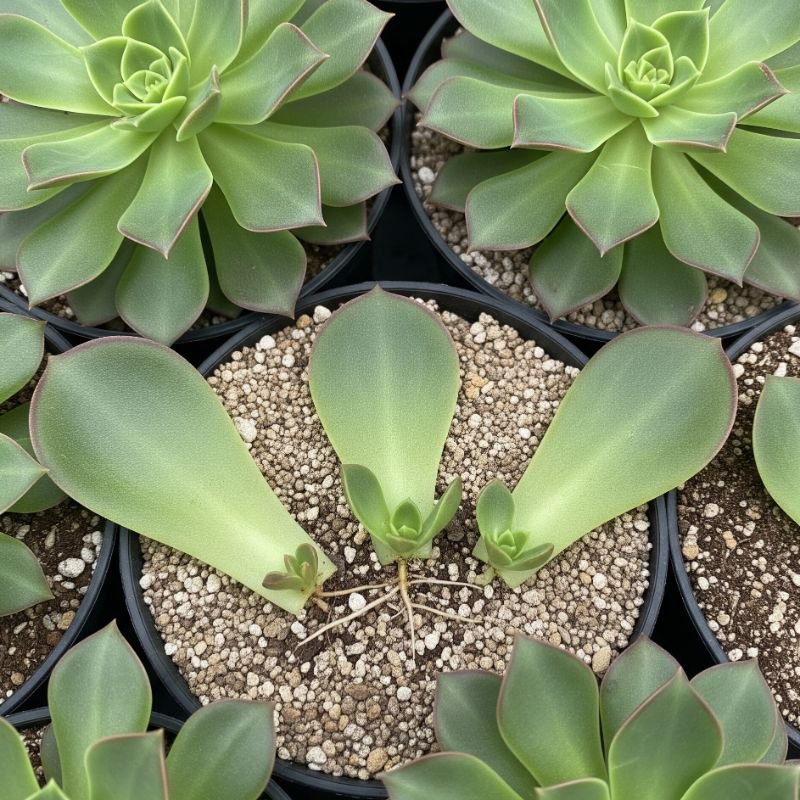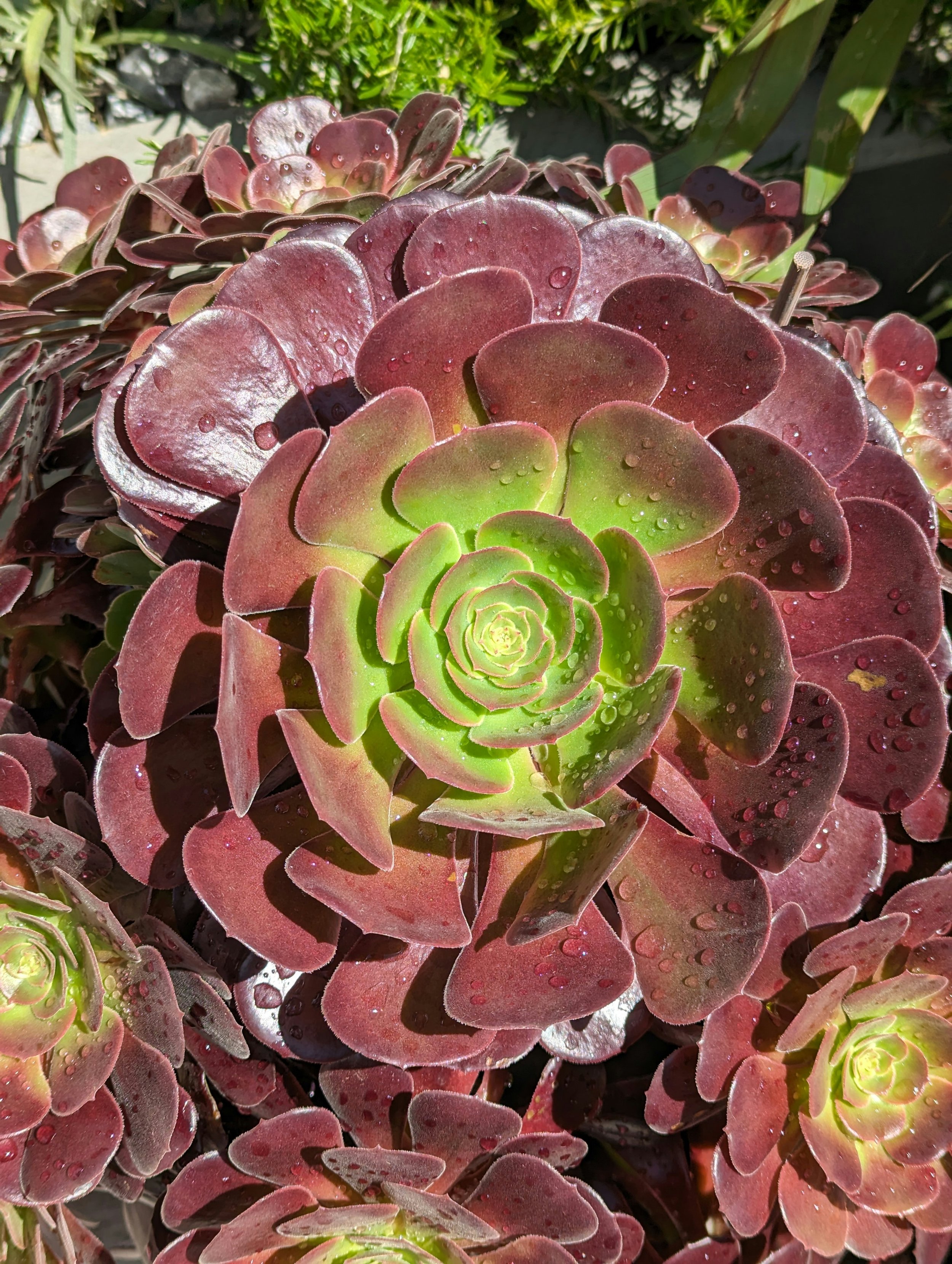How to Propagate Aeonium: Step-by-Step Guide
Learn how to propagate Aeonium succulents with our detailed step-by-step guide. Master cuttings, offsets, and leaf propagation methods.
Well, well, well – look who's fallen head over heels for those stunning rosette-shaped Aeoniums! Can't say I blame you one bit. These architectural beauties have this amazing ability to make any garden or windowsill look like it belongs in a fancy magazine spread.
Here's the thing though – once you've got one gorgeous Aeonium, you're gonna want more. And honestly, who wouldn't? These succulents are like potato chips; you can't have just one! The good news? Propagating Aeoniums isn't rocket science, but there are definitely some tricks of the trade that'll make the difference between success and, well... disappointment.
Whether you're looking to expand your collection, share with friends, or just want to try your hand at plant parenting, this guide's got your back. We'll walk through everything from the easiest methods to some pro-level techniques that'll have you feeling like a succulent wizard in no time.
By the time you're done reading, you'll have all the know-how to turn one Aeonium into an entire army of these spectacular plants!
Understanding Aeonium Basics Before You Dive In
Before we jump into the nitty-gritty of propagation, let's get our bearings straight about what makes these plants tick. Trust me, understanding your Aeonium's personality will make propagation so much smoother.
What Makes Aeoniums Special?
Aeoniums are definitely the drama queens of the succulent world – and I mean that in the best possible way! These Mediterranean natives have this incredible talent for creating perfect geometric rosettes that look almost too good to be true.
Unlike many succulents that store water in thick, fleshy leaves, Aeoniums have a different game plan. Their leaves are typically thinner and more delicate, which means they've got their own special needs when it comes to propagation.
Most Aeoniums follow a monocarpic growth pattern, meaning the main rosette will eventually bloom and then die back. But here's the kicker – they usually produce plenty of offsets before that happens, so you're rarely left empty-handed!
Growth Patterns and Timing
Here's where timing becomes everything! Aeoniums are winter growers, which means they're most active during cooler months and go semi-dormant during hot summers. This quirky schedule affects when and how you should propagate them.
The best time for propagation? Late fall through early spring, when these beauties are in their active growth phase. Trying to propagate during summer dormancy is like trying to wake up a teenager on Saturday morning – technically possible, but you're fighting an uphill battle!
Essential Methods in Your How to Propagate Aeonium: Step-by-Step Guide Arsenal
Alright, let's get down to business! There are several ways to propagate Aeoniums, and each method has its own sweet spot depending on your plant's condition and your patience level.
Method 1: Stem Cutting Propagation (The Crowd Favorite)
This is hands-down the most reliable method for most Aeonium varieties. It's like the comfort food of propagation – not always the fanciest, but it gets the job done beautifully.
What You'll Need:
Sharp, clean pruning shears or knife
Well-draining potting mix
Small pots or containers
Rooting hormone (optional but helpful)
A bright, indirect light spot
Step-by-Step Process:
Choose Your Cutting: Look for a healthy stem that's at least 2-3 inches long with a nice rosette on top. Avoid any stems that look mushy, discolored, or generally unhappy.
Make the Cut: Using your sharp, clean tool, cut the stem cleanly about 2-3 inches below the rosette. Don't hack at it – one clean slice does the trick!
The Waiting Game: Here's where patience pays off. Let your cutting sit in a dry, shaded spot for 3-7 days until the cut end forms a callus. This prevents rot – skip this step at your own peril!
Plant Time: Once callused, plant the cutting in well-draining soil, burying about half the stem. Don't water immediately – wait a few days to let it settle in.
Water Wisely: Start with light, infrequent watering. You want the soil barely moist, not soggy. Too much water and you'll end up with mush instead of roots.
Method 2: Offset Division (Nature's Gift)
When your Aeonium starts producing little babies around its base, you've hit the jackpot! These offsets are basically free plants just waiting to be separated.
The Process:
Locate the Offsets: Look for small rosettes growing from the base or along the stem of the mother plant.
Gentle Separation: Carefully remove the offset, trying to get some roots if possible. Sometimes they pop right off, other times you might need to use a clean knife.
Callusing Period: Just like with stem cuttings, let offsets callus for a few days before planting.
Individual Homes: Plant each offset in its own small pot with well-draining soil.
Method 3: Leaf Propagation (The Challenge Mode)
Now, here's where things get interesting – and a bit tricky! Leaf propagation with Aeoniums isn't as straightforward as with other succulents, but it's definitely doable with the right approach.
Why It's Tricky:
Aeonium leaves are typically thinner and more delicate than those chunky Echeveria or Jade plant leaves. They don't store as much water and energy, making successful propagation a bit more challenging.
The Technique:
Leaf Selection: Choose plump, healthy leaves from the lower part of the rosette. You want leaves that come off cleanly with no tearing.
Drying Time: Let leaves dry and callus for several days – even longer than you would with stem cuttings.
Planting Setup: Place callused leaves on top of barely moist, well-draining soil. Don't bury them – just let them rest on the surface.
Environmental Control: Keep in bright, indirect light with good air circulation. Mist very lightly if the soil becomes completely dry.
Mastering the How to Propagate Aeonium: Step-by-Step Guide Like a Pro
Ready to take your propagation game to the next level? Here are some insider tips that separate the rookies from the pros.
Soil Mix Secrets
The right soil mix can make or break your propagation success. Standard potting soil is usually too heavy and holds too much moisture for Aeoniums.
The Perfect Mix Recipe:
2 parts quality cactus/succulent soil
1 part perlite or pumice
1 part coarse sand
A handful of small bark chips (optional but beneficial)
This combination drains quickly while still holding just enough moisture for developing roots.
Environmental Factors That Matter
Light: Bright, indirect light is your sweet spot. Direct sun can stress newly propagated plants, while too little light leads to weak, elongated growth.
Temperature: Aeoniums prefer cooler temperatures, especially during propagation. Aim for 60-75°F if possible.
Humidity: Moderate humidity helps, but good air circulation is crucial to prevent fungal issues.
Air Movement: A small fan can work wonders in preventing stagnant air around your propagation setup.
Watering Wisdom for Propagation Success
This is where many folks go wrong! Overwatering is the number one killer of Aeonium propagations.
The Golden Rules:
Less is always more during the initial rooting phase
Wait until soil is completely dry between waterings
Water around the cutting, not directly on it
Use the "soak and dry" method once roots are established
Troubleshooting Common Aeonium Propagation Problems
Even the best of us run into hiccups sometimes. Here's how to diagnose and fix the most common issues.
Problem: Cuttings Turning Mushy
Symptoms: Soft, discolored, or mushy stems or leaves
Causes: Too much moisture, insufficient callusing time, or poor air circulation
Solutions: Remove affected parts, improve drainage, increase air movement, and be more patient with callusing
Problem: No Root Development
Symptoms: Weeks pass with no visible root growth
Causes: Wrong season (summer dormancy), too dry conditions, or poor cutting selection
Solutions: Wait for active growing season, provide gentle bottom heat, ensure minimal moisture
Problem: Weak, Stretchy Growth
Symptoms: Long, pale stems with widely spaced leaves
Causes: Insufficient light or too much heat
Solutions: Move to brighter location, provide cooler temperatures during growth phase
Problem: Leaf Drop on New Plants
Symptoms: Lower leaves yellowing and dropping
Causes: Natural adjustment process or watering issues
Solutions: Usually normal – adjust watering if excessive
Seasonal Considerations for Optimal Success
Timing really is everything when it comes to Aeonium propagation! Understanding their seasonal preferences will dramatically improve your success rate.
Winter/Spring Propagation (Prime Time)
This is when Aeoniums are naturally growing and most receptive to propagation. You'll see faster rooting, better establishment, and healthier overall development.
What to Expect:
Faster root development (2-4 weeks)
More vigorous growth once established
Higher success rates overall
Summer Propagation (Challenging but Possible)
During their dormant period, Aeoniums are much less responsive to propagation efforts. However, it's not impossible if you're patient and adjust your expectations.
Special Considerations:
Longer rooting times (6-8 weeks or more)
Minimal watering required
Focus on maintaining rather than encouraging growth
Advanced Techniques and Varieties
Once you've mastered the basics, there are some advanced techniques and special considerations for different Aeonium varieties.
Species-Specific Tips
Aeonium arboreum:
These tree-like varieties are excellent for stem cutting propagation and often produce abundant offsets.
Aeonium tabuliforme (Flat Top):
The unusual flat growth pattern requires special handling – avoid disturbing the center rosette structure.
Aeonium haworthii:
These smaller varieties propagate well from both cuttings and offsets, but require more delicate handling.
Advanced Propagation Techniques
Air Layering for Large Specimens
For mature, woody Aeoniums, air layering can be incredibly effective:
Select a node along the stem where you want roots to develop
Wrap moist sphagnum moss around the area
Cover with plastic wrap and secure
Keep moss consistently moist until roots develop
Cut below the new root system and plant
Grafting Experiments
While not common, some adventurous propagators experiment with grafting rare varieties onto hardy rootstock – definitely advanced territory!
Creating Your Propagation Station
Setting up a dedicated space for propagation makes the whole process smoother and more enjoyable.
Essential Equipment List
Various sized pots and trays
Quality soil ingredients
Sharp, clean cutting tools
Labels and markers
Spray bottle for misting
Small shovel or spoon for planting
Organization Tips
Group propagations by method and timing
Keep detailed records of what you've done when
Create a rotation system for checking progress
Maintain a "quarantine" area for new propagations
Conclusion
Mastering Aeonium propagation opens up a whole world of possibilities for expanding your succulent collection and sharing these architectural beauties with fellow plant lovers. Remember, success comes from understanding their unique needs, timing your efforts with their natural growing cycles, and practicing patience during the rooting process. With the techniques covered in this comprehensive guide, you'll soon be propagating Aeoniums like a seasoned pro, creating stunning displays that showcase these magnificent rosette-forming succulents in all their glory!
Read next: How to Grow and Care for Aeonium Black Rose
Frequently Asked Questions
Q1: How long does Aeonium propagation typically take?
Root development usually takes 2-6 weeks, depending on season and propagation method used.
Q2: Can I propagate Aeoniums in water first?
Water propagation isn't recommended as Aeoniums prefer well-draining conditions throughout the rooting process.
Q3: What's the success rate for different propagation methods?
Stem cuttings have highest success (80-90%), offsets are very reliable, leaf propagation more challenging.
Q4: Should I use rooting hormone on Aeonium cuttings?
Rooting hormone helps but isn't essential; Aeoniums root naturally when conditions are right.
Q5: Can I propagate Aeoniums during their blooming period?
It's possible but not ideal; plants focus energy on flowering rather than root development.






